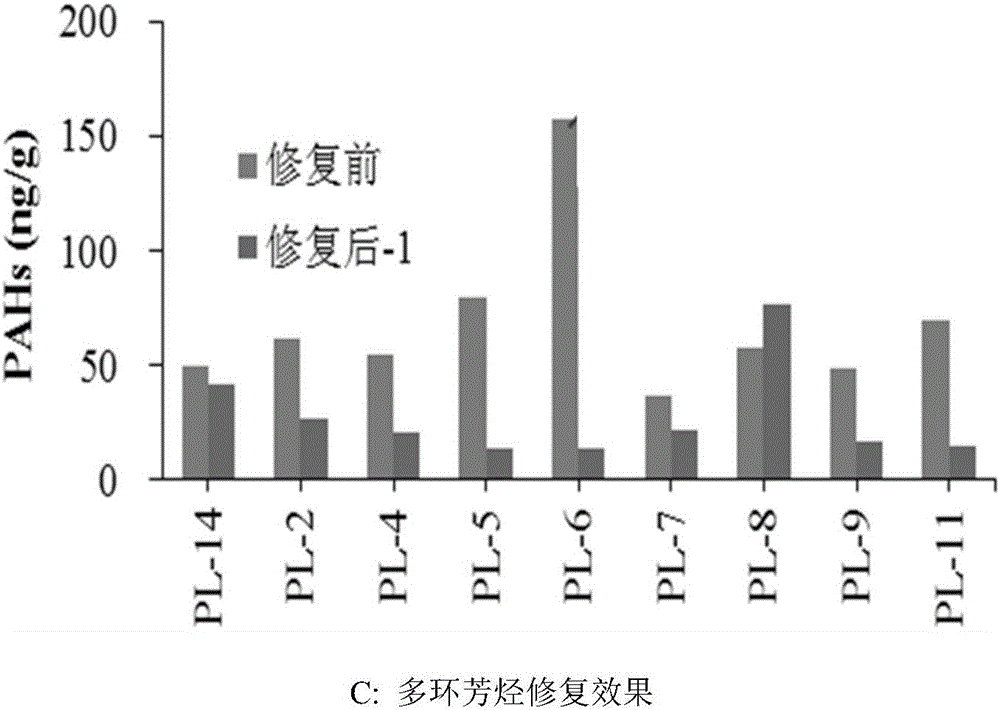Method for repairing sediment pollution in open sea area
A sea area sediment and repair method technology, applied in the field of water environment treatment by microorganisms, can solve the problems of few demonstrations and projects, lack of open sea sediment pollution microbial repair methods and applications, etc., to reduce workload and working hours, increase The effect of pollutant degradation and the effect of ensuring the repair effect
- Summary
- Abstract
- Description
- Claims
- Application Information
AI Technical Summary
Problems solved by technology
Method used
Image
Examples
Embodiment 1
[0049] Example 1 Screening and combination of efficient petroleum degrading bacteria
[0050] Using the microorganisms in the sediments of the Yantai sea area as the source of highly efficient oil-degrading bacteria, the indigenous strains with good degradation effects on oil pollution were screened, and the bacterial liquid was mixed according to the ratio of the maximum degradation effect, adsorbed on the surface of zeolite, and wrapped with a coating agent, and finally Carry out subcontracting and release, and complete the bioremediation of oil-polluted sediments in designated sea areas of the Bohai Sea.
[0051] (1) Strain screening: Weigh 2g of petroleum-contaminated seawater sediment samples and add them to Erlenmeyer flasks filled with seawater culture medium and freshwater culture medium respectively, carry out shaking culture on a constant temperature shaker at 30°C and 180r / min for 3 days, and then pipette Insert 1 mL of the culture solution into the screening medium...
Embodiment 2
[0064] Example 2 Sea Area Sediment Oil Contaminated Microbial Restoration
[0065]Remediation of oil pollution in sediments in the Bohai Sea.
[0066] (1) Restoration strains: Acinetobacter calcoacetate, Pseudomonas putida and Bacillus shamford.
[0067] (2) Fermentation and mixing of bacterial strains: the three bacterial strains are respectively subjected to large-scale fermentation, and the respective concentration of the bacterial liquid after fermentation is 2-3OD. After fermentation, Acinetobacter calcoacetate, Pseudomonas putida, and Bacillus spp. were mixed according to the ratio of the number of colonies of the strains to 3:2:4. 9 CFU / ml, mix and store in a refrigerator at 4 degrees Celsius.
[0068] (3) Adsorption and wrapping of bacterial liquid: the mixed bacterial liquid is mixed and adsorbed according to the mass ratio of bacterial liquid and zeolite at 2:1, and the adsorption time is 2 hours. After the water content is 60%-70%, spray 7wt% polyglutamic acid so...
Embodiment 3
[0080] Microbial remediation of furazolidone antibiotic pollution in embodiment 3 seawater
[0081] The combined bacterial agent of Acinetobacter calcoacetate, Pseudomonas putida and Bacillus suffolus has a good degradation effect on furazolidone antibiotics in seawater.
[0082] (1) Microbial strains: Acinetobacter calcium acetate, Pseudomonas putida, Bacillus shamford;
[0083] (2) Combination of bacterial strains: According to the three-level three-factor orthogonal test, the concentration ratio of Acinetobacter calcoaceticus, Pseudomonas putida, and Bacillus shamford was mixed in a concentration ratio of 2:2:1, and finally The total bacterial count is 1×10 8 Inoculate in the inorganic salt peptone liquid medium containing 500ppm furazolidone for cultivation, and use the inorganic salt peptone liquid medium containing furazolidone without inoculation of the degradation strain as a control. At different time points, 500ul of the culture solution was taken out, centrifuged ...
PUM
 Login to View More
Login to View More Abstract
Description
Claims
Application Information
 Login to View More
Login to View More - Generate Ideas
- Intellectual Property
- Life Sciences
- Materials
- Tech Scout
- Unparalleled Data Quality
- Higher Quality Content
- 60% Fewer Hallucinations
Browse by: Latest US Patents, China's latest patents, Technical Efficacy Thesaurus, Application Domain, Technology Topic, Popular Technical Reports.
© 2025 PatSnap. All rights reserved.Legal|Privacy policy|Modern Slavery Act Transparency Statement|Sitemap|About US| Contact US: help@patsnap.com



